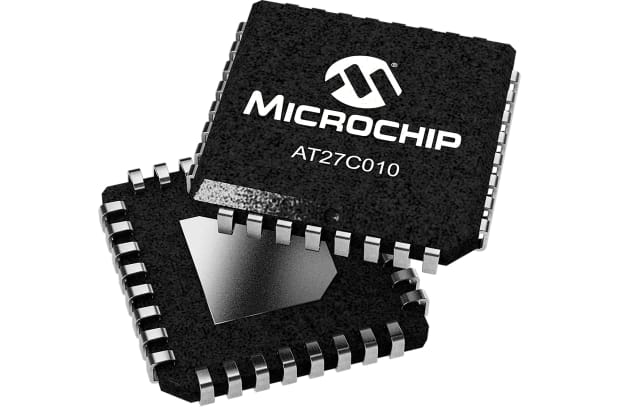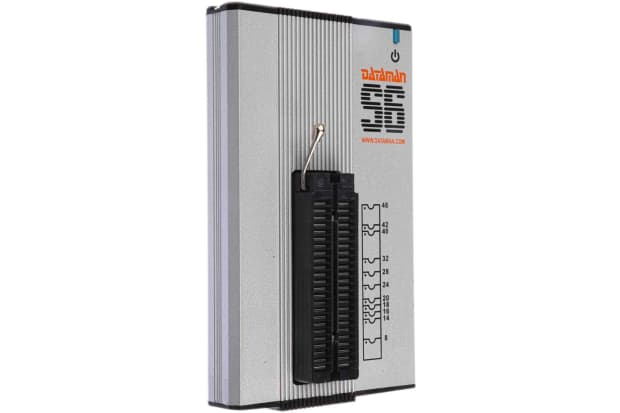- Published 24 Jan 2023
- Last Modified 29 Aug 2023
- 7 min
A Guide to EEPROM
Our EEPROM guide covers what it is, how it’s used, and the benefits of EEPROM chips in devices.

EEPROM is an acronym that stands for Electrically Erasable Programmable Read-Only Memory. It denotes a type of rewritable storage chip or memory package that can continue to hold its stored information even without power. This is known as non-volatile memory.
In this regard, EEPROM memory (also called E2PROM) is somewhat like flash memory, the type you will commonly get on an SD card or USB thumb drive. Indeed, flash memory is technically considered a type of EEPROM.
However, there are some important differences between standard EEPROM ICs sold as computer or microcontroller chips, and other popular memory types - including flash storage.
In this beginner’s guide to EEPROM memory products, we will highlight these similarities and differences. We will also outline some of the main uses for the various types of EEPROM chips, programmers and readers sold online in the UK and elsewhere.
By the end of the guide, you will understand the key features and functions of EEPROM vs. those found in other ROM chips and storage media types.
What is EEPROM?
EEPROM stands for Electrically Erasable Programmable Read-Only Memory. To gain a better understanding of what these chips do, and what sort of applications EEPROM products are used for, it helps to break down the meaning of each word in its full name:
Electrically Erasable
- When connected to a power supply (PSU) via a motherboard or other suitable electronic circuit, the stored contents of EEPROM modules can be erased (deleted), either entirely or on an individual byte-per-section basis
Programmable
- PROM, or programmable ROM, indicates a module whose contents are intended to be written to memory after the chip has been installed into a system
- When attached to an appropriate circuit, for example as part of a desktop computer system, the application of electrical voltages to EEPROM chips allows users to modify or reprogramme the contents stored on the memory module
Read-Only
- Read-only memory (ROM and PROM) refers to modules designed for the long-term storage of information that does not change dynamically
- Non-dynamic data includes most types of user files, firmware, and some programs or code - elements that are not intended to receive regular automatic updates
- Like most ROM chips, EEPROM modules provide non-volatile functionality. This means any information stored on the chip can still be retrieved after a zero-power state, i.e. after the device or computer it is installed in has been turned off and back on again. This is not the case with RAM (Random Access Memory). RAM is designed for performing dynamic tasks rather than long-term information storage and is effectively wiped at the instant it reverts to a powered-off state
In simple terms, EEPROM is a type of memory module that can be used to hold, retrieve and delete information when installed in a computer or other electronic device.
Various other memory chip types also perform these functions, but with different core features and capabilities to true EEPROM. Among the most notable and widely used of these is flash memory.
How EEPROM Relates to Flash Memory and Memory Sticks
Flash memory is a popular consumer standard today, ideal for saving all kinds of multimedia files intended for both long-term and short-term storage and retrieval.
In many ways, flash products are seen as the successor to modern EEPROM, which in turn gradually replaced the older EPROM standard starting in the 1980s. However, EEPROM still offers some valuable features in several specific scenarios that cannot be readily achieved using flash memory.
SD cards and USB drives are two of the most common formats you can buy flash memory in. Flash is a relatively low-cost and easy to use digital storage medium today, with increasingly high capacity modules now engineered to fit into very small form factor devices and packages.
Flash memory is a type of EEPROM, but one that is specifically designed for high density, high-speed data storage and retrieval. In other words, flash ROM is an ideal solution for saving multiple larger data files to a single high-capacity module.

Flash Memory and Erase Block Size
A USB stick flash drive or an SD card in a digital camera, for example, will perform very well at holding and accessing hundreds or even thousands of relatively large documents, images or video files.
However, there is a downside. Like most ROM types, flash memory works by erasing and then rewriting entire chunks of storage every time you amend, move, or reprogramme the contents. Individual erase cycles are quite slow to perform, so to achieve the sorts of speeds and capacities most users want from this type of memory, flash is normally built and arranged in large erase blocks.
In any memory package, an erase block refers to the smallest possible amount of data that can be erased or rewritten at any one time. The size of these blocks is important for two key reasons. Firstly, because it affects overall performance speed, and secondly because all memory chips offer a limited number of read-write cycles before they wear out.
EEPROM vs. Flash Memory
Most modern consumer-grade flash chips have erase blocks set to 512 bytes or larger. That is significantly bigger than some other more specialised ROM types, including byte-programmable EEPROM. Because EEPROM offers much smaller erase blocks than flash memory, it is a far better choice for operations that require saving and accessing very small datasets.
The ability to allow for the erasing and reprogramming of single bytes or individual words at a time makes it ideal for storing and retrieving very minimal files. Devices relying on EEPROM for parameters or calibration coefficient data is a common scenario. Other typical uses include storage of elements like counters, bootloader EEPROM configurations, powering remote keyless systems, and keeping state between power transitions.
Smaller erase blocks mean EEPROM typically performs slower than flash memory, especially when writing larger amounts of data. They are also arranged at a lower density, so overall storage capacity will be considerably reduced vs. a flash module for a chip of the same physical size and surface area. However, it should also be noted that various high capacity EEPROMs are widely available today.
This design also gives EEPROM modules a far higher endurance per cell rating. Compared to a flash chip, modern EEPROM can often withstand up to ten times the number of total write cycles throughout its working life.
How EEPROM Compares to EPROM Memory

The differences between EEPROM vs. EPROM are largely due to the missing E in the older version.
EEPROM denotes an electrically erasable memory module. By contrast, the older EPROM standard was often erasable (rewritable), but not electronically. Instead, most 1970s and early 1980s EPROM chips had to be manually erased.
This was usually done by exposing a small transparent window made from fused quartz on the outside of the module to a source of high-intensity UV light. This would then penetrate through to the silicon surface of the die itself, allowing ionisation to gradually dissipate any stored charge within the module.
The process could be cumbersome and time-consuming. Modules almost always had to be fully removed from their host devices to be erased effectively and exposing the silicon to ultraviolet radiation meant erasing all the stored data at once.
Modern EPROM chips are still made for specific device types, offering a cheap and practical solution for performing certain rigid memory tasks. UV lamp technology has also improved dramatically, meaning that versions with a manual erase window can now be wiped much more quickly. Note that some current modules labelled as EPROM are manufactured without the window, and thus are not designed to be rewritten once programmed.
Parallel EEPROM vs. Serial EEPROM
Parallel EEPROM memory and serial EEPROM memory refer to the two possible physical configurations of EEPROM ICs on a single memory module. Specifically, they describe the number and layout of pins on an EEPROM chip and the resulting bus width for facilitating communication between memory modules and other connected devices.
In very simple terms, parallel EEPROM is generally viewed as faster in operation, being more straightforward for a processor (CPU) to talk to. Serial EEPROM devices, however, are considerably cheaper to manufacture and buy, thanks in large part to the reduced quantities of pins and packaging required in the assembly of a serial module.
Bear in mind that EEPROM is typically relied on only to perform brief tasks, often exclusively during device start-up (such as EEPROM boot recovery). It runs at modest speeds and is seldom subject to any lengthy write operations. Taking these considerations into account, some users might question the value of choosing parallel EEPROM over serial memory products in terms of seeing any significant real-world performance gain.
EEPROM Programmers and Readers

An EEPROM programmer is a device used for writing (transferring) the code or data to a suitable memory module that enables it to perform the necessary task. They are also known as chip programmers or IC programmers.
Depending on the model and brand, EEPROM programmers may allow the user to configure a chip by either plugging it into a socket on the device itself or by attaching the unit to a PCB (printed circuit board) with the EEPROM already installed. Chip programmers will connect to a computer via USB, parallel port or LAN (Local Area Network) port and can transmit signals to the target device through a combination of software and serial connection pins or a serial interface.
Similarly, EEPROM readers are devices used to read the code already programmed onto a memory module and are usually connected via the same range of interfaces. There are many models of commercial EEPROM readers sold cheaply online and commercial devices will often be able to perform both programming and reading tasks for a single memory chip.
Where to Next?
Related links
- A Comprehensive Guide to Flash Memory
- A Guide to CPUs and Microprocessors
- A Complete Masking Tape Buying Guide
- The Complete Guide to Cordless Screwdrivers
- A Complete Guide to LED Displays
- A Guide to Spacers and Standoffs
- A Complete Guide to Aluminium Electrolytic Capacitors
- A Guide to Cable Conduit & Trunking

